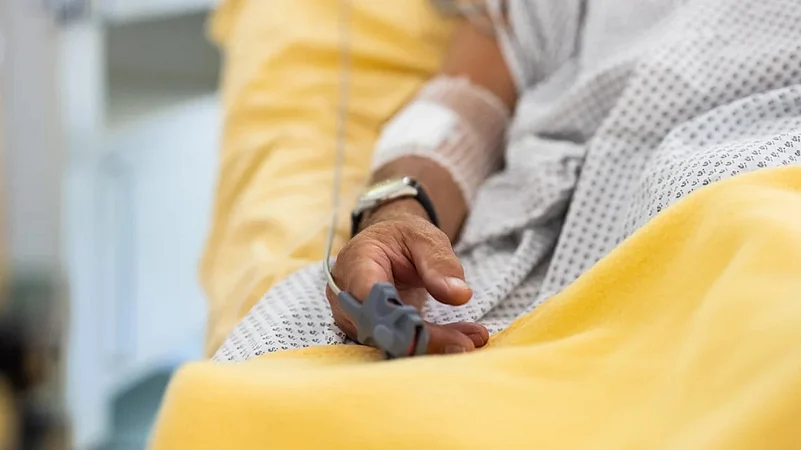An elderly man from the Kenai Peninsula in Alaska has become the first person to die after contracting Alaskapox, a newly identified viral illness. He was receiving medical care in a hospital when he succumbed to the disease in late January, as confirmed by officials.
The Alaskan health department reported that he had a previous history of a weakened immune system induced by drug use, which likely exacerbated the severity of his illness.
The victim affected was among just seven documented cases of Alaskapox infections, with the first case identified in 2015 in an adult experiencing a localized rash and swollen lymph nodes.
All prior patients diagnosed with the virus, who were also from the Fairbanks region, experienced mild infections and did not necessitate treatment.
Officials have described Alaskapox, also known as AKPV, as a double-stranded DNA virus with zoonotic characteristics, primarily circulating among Alaska's native mammals but occasionally transmitting to humans.
Symptoms of the disease include one or more skin lesions, swollen lymph nodes, and muscle pain.
Officials stated that the man's exposure to the virus was "unclear," although he had reported caring for a stray cat at his home, which may have scratched him, potentially facilitating transmission.
In September, the man noticed a red bump in his armpit and received antibiotics. However, his symptoms worsened as he experienced fatigue and increased pain in the area and shoulder.
His right arm's range of motion was affected, prompting his transfer to a hospital in Anchorage. Further symptoms, including pox-like lesions, were reported, according to the case report.
An "extensive battery" of tests was conducted, revealing a positive result for cowpox.
Although his condition showed improvement one week into the therapy, he subsequently experienced delayed wound healing, respiratory issues, and kidney failure, ultimately leading to his death.
About a week after beginning treatment with intravenous medications, the man started to show signs of improvement. However, he passed away in late January due to kidney failure and other systemic declines, as reported in the bulletin.
According to the report, the transmission of AKPV among small mammals warrants "increased statewide awareness" among medical professionals.
The report outlined nine recommendations for individuals suspected of having Alaskapox, including refraining from touching lesions, ensuring they remain dry and covered, and adhering to proper hand hygiene practices.
The Alaska Division of Public Health has provided crucial information regarding the emergence and characteristics of the Alaskapox virus, shedding light on its symptoms, transmission, and preventive measures.
What is Alaskapox Virus?
Alaskapox virus is classified as an orthopox virus and was initially identified in 2015 in a woman residing near Fairbanks. As of December 2023, six additional human infections have been documented. Belonging to the orthopoxvirus group, this virus infects mammals and induces skin lesions.
What are the Symptoms of the Alaskapox virus?
Individuals infected with the Alaskapox virus typically present with one or more skin lesions, accompanied by symptoms such as swollen lymph nodes and joint or muscle pain. Many Alaskapox patients initially mistook their symptoms for a spider or insect bite. The majority experienced mild illnesses that resolved spontaneously within a few weeks. However, one patient with an immunocompromised condition developed severe disease and ultimately succumbed after a prolonged illness.
Where is Alaskapox virus found?
Six of the documented infections were in individuals residing in the Fairbanks North Star Borough (FNSB), while one case occurred in a person living in the Kenai Peninsula Borough. Although animal trapping studies have confirmed the virus's presence in small mammals in FNSB, it is probable that the virus is widespread among Alaska's small mammals, suggesting additional human infections may have transpired but remained undetected. Increased animal testing is underway to enhance comprehension of the virus's distribution among animal populations across Alaska.
Where does the virus come from?
The Alaskapox virus is believed to primarily inhabit small mammal populations. Through two rounds of small mammal sampling conducted in 2020 and 2021, the presence of the virus has been confirmed in two specific species within the Fairbanks North Star Borough: red-backed voles and shrews. However, evidence also indicates the virus is present in various other small mammal species across Alaska, and its prevalence extends beyond the boundaries of the Fairbanks North Star Borough. The exact mechanism of transmission from animals to humans remains unclear, but contact with small mammals and potentially domestic pets that interact with these animals could play a role.
Can Alaskapox patients spread the virus to others?
Although human-to-human transmission of AKPV has not been observed thus far, certain orthopoxviruses have the potential to spread through direct contact with lesions, especially through contact with secretions from broken skin lesions. As a precaution, individuals with skin lesions possibly caused by Alaskapox are advised to keep the affected area covered with a bandage and refrain from sharing bedding or other linens that have been in contact with the lesion.
How to know if you have Alaskapox?
If you suspect you have Alaskapox, it's essential to consult a healthcare provider. They can evaluate your symptoms to determine if they may be attributed to Alaskapox or another condition. Keep the lesion covered and avoid touching it.
Actions for Healthcare Providers Suspecting Alaskapox in a Patient
Healthcare providers who suspect a patient may have Alaskapox should contact the Alaska Section of Epidemiology at 907-269-8000 for assistance with testing and potential treatment. If no alternative diagnosis is identified, advise the patient to keep the lesion covered with a bandage and document it by taking photographs.
















